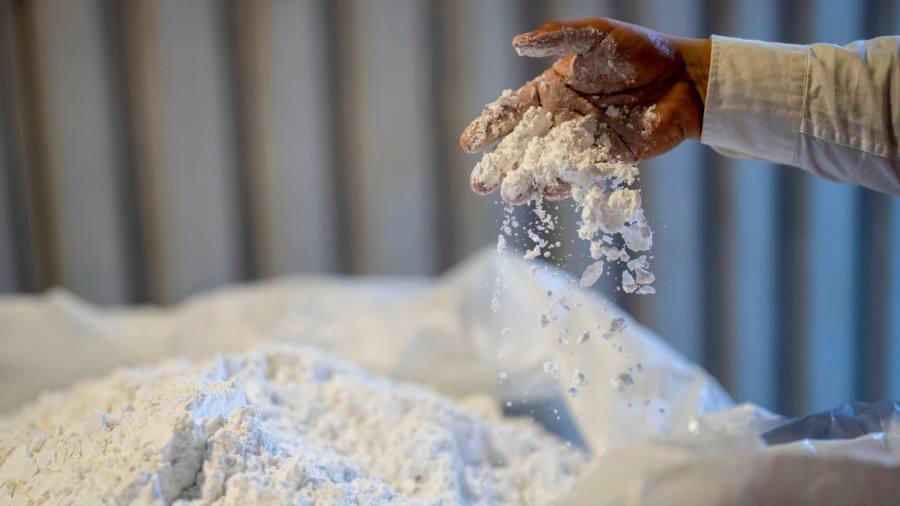
Receive free Mining updates
We’ll send you a myFT Daily Digest email rounding up the latest Mining news every morning.
The writer served in the White House as special assistant to the president and senior director for international economics from 2021 to 2023
Fast forward to 2031. The EU exhausted its €250bn Green Deal months ago; the US Inflation Reduction Act is also winding down, and things are not going well. Electric vehicle sales have been stymied by global shortages and price spikes in lithium and other minerals. Without enough minerals to stock assembly lines, workers across America’s ‘Battery Belt’ are furloughed, with similar supply problems plaguing Europe. Talks with the new critical minerals producers’ cartel have been halting, partly because China — having acquired large stakes in the mines of member countries — is directing supply to its own battery manufacturers.
It doesn’t need to be this way. Industry analysts are all flashing the same warning lights: achieving the energy transition will demand far more lithium and other minerals by 2030 than the world is on track to produce. Responsibly boosting global production is paramount. Avoiding critical minerals shortages will require some 330 new mines over the next decade, according to Benchmark Minerals, even assuming maximum progress on recycling. This includes 59 new lithium mines; the world currently has a couple of dozen.
This is not a problem any country can solve alone. The magnitude of supply needed to fend off looming shortfalls is larger than any one nation could conceivably mine. The US and its partners can and should co-operate to boost overseas production. Neither is it a problem the market can easily manage by itself. There are several reasons to doubt the old saying, “the cure for high prices is high prices”. After all, lithium prices have risen 800 per cent over the past three years — and still, mining companies, wary of price volatility, aren’t investing anywhere near the rates needed.
America’s recent critical minerals deals with Japan, and soon Europe, offer a promising opening. But to avoid global shortages, policymakers must go much further. To start with, they’ll need to bring exporters to the table, not just buyers — stitching Washington’s bilateral deals with Japan and the EU into a new critical minerals pact with leading net importing and exporting countries. Absent this sort of expansion, the world could read US agreements with Tokyo and Brussels as an attempted ‘buyers club’, which risks stoking calls from some exporters to form an Opec-like cartel for critical minerals.
To make a new minerals club work, buyer countries should offer incentives to responsibly expand production. This starts with treating battery minerals as essential commodities and adapting policy accordingly. Just as with agriculture and oil, tailored measures such as price insurance — essentially a contract giving the seller an option to sell a certain quantity of minerals at a given price and time — will be important for encouraging investment amid high price volatility. The US and other net importers could also offer tariff reductions, concessional financing and access to technology, all contingent on stronger labour and environmental standards.
Next, the US and other net importers should couple longer-term purchase agreements with more generous value sharing and royalty models for exporting governments. Mining executives have told me they would oblige so long as mineral-rich governments guarantee existing investments will not be nationalised, which seems reasonable.
Third, all sides would agree to diversify their supply chains which is especially important in areas like minerals processing, where China controls roughly 85 per cent of the market. Members would also co-operate on demand-reducing innovation and recycling. The magnitude of the predicted deficits implies a bet on technology. But the most promising technologies — such as batteries that use sodium instead of lithium — still face real hurdles.
With these measures, everyone wins: supply is boosted, and net exporters gain investment and more generous terms on new deals. Affected communities win more profits. We make progress decarbonising one of the world’s dirtiest industries (Indonesia, the world’s leading nickel producer, has a carbon footprint up to 6 times the industry average). And the guaranteed supply may even induce climate commitments from other large emitters. Convincing India to ban internal combustion engines becomes a lot easier, for example, if EV battery shortages aren’t an acute risk.
The history of essential commodities, especially those pertaining to energy, is heavily arbitrated by governments. The headlines in a decade could be positive ones: a thriving EV manufacturing sector, transatlantic climate goals reached and the fraught geopolitics of oil largely replaced with secure, clean energy. But that depends on Washington and Brussels acting now.